Key takeaways:
- International cuisines reflect cultural heritage, with each dish telling a unique story through its ingredients and preparation.
- Culinary education fosters community and innovation, allowing chefs to embrace both tradition and modern techniques.
- Exploring regional cuisines deepens appreciation for cultural identity and shared experiences, highlighting food’s role in connecting people.
- Patience and collaboration in cooking lead to richer flavors and lasting memories, emphasizing the emotional impact of sharing meals.
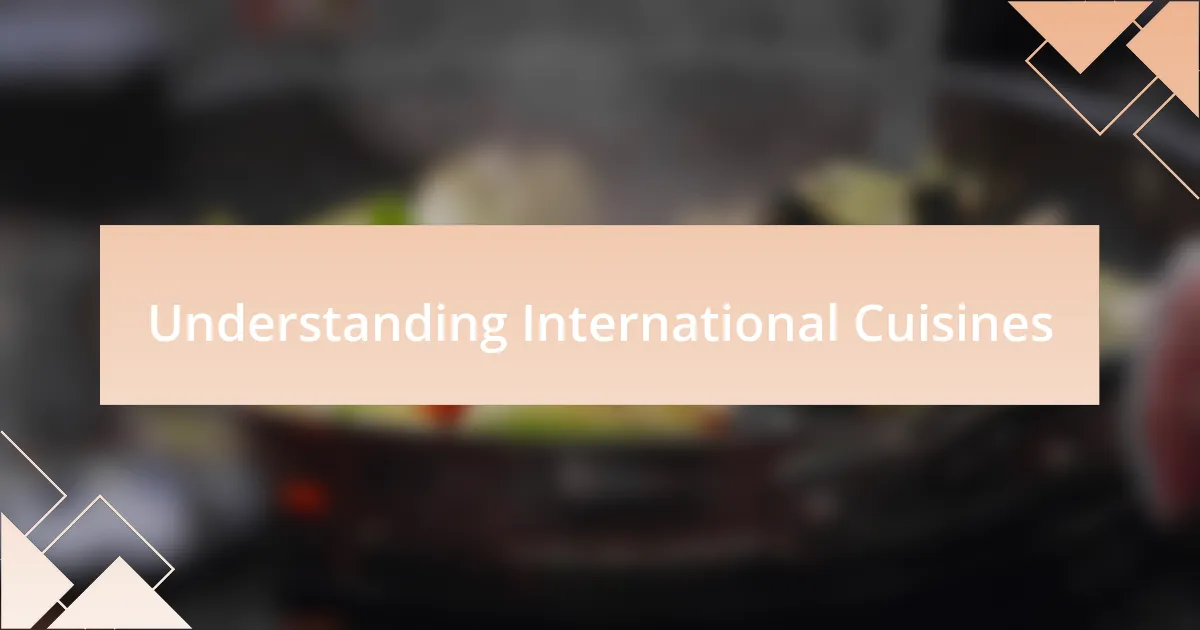
Understanding International Cuisines
Understanding international cuisines is like embarking on a culinary adventure. Each dish tells a story, reflecting the culture, history, and geography of its origin. I remember savoring a fragrant bowl of pho in a bustling market in Vietnam, and it struck me how the balance of flavors and textures captured both the vibrancy and complexity of the country itself.
It’s fascinating how certain ingredients can transcend borders, yet they transform into something uniquely local. For instance, I’ve tried different versions of curry across India, Thailand, and the Caribbean, each with its own distinct twist. What makes these variations so compelling? It’s like spices are the storytellers, sharing tales of tradition, regional availability, and even climate.
Diving deeper into international cuisines opens up so many questions about community and sustainability. When I explored the concept of farm-to-table dining in Mediterranean countries, it became clear that food is not just about sustenance—it’s about connection. How does one dish bring people together? This understanding has reshaped my culinary experience, making every meal an opportunity to learn and connect.
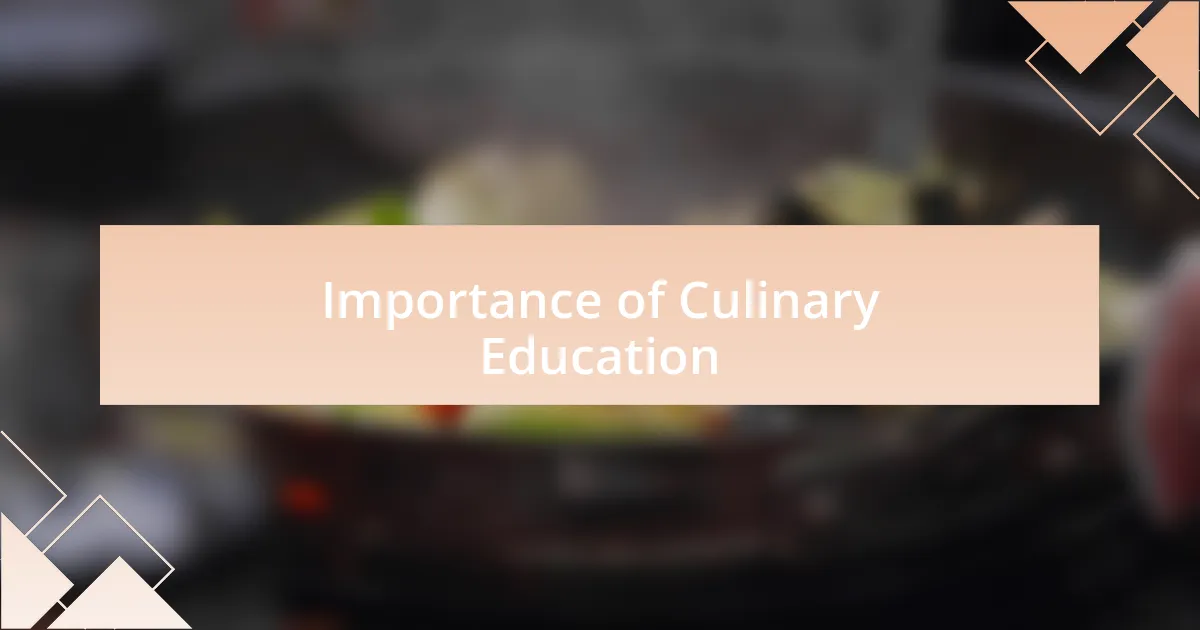
Importance of Culinary Education
Culinary education plays a crucial role in enriching our understanding of food cultures worldwide. I remember attending a workshop where I learned to prepare a traditional Italian dish from a local chef. This experience not only improved my technical skills but also deepened my appreciation for the passion and history behind each recipe. Doesn’t it feel wonderful when you realize that mastering a dish also means embracing its story?
Moreover, culinary education fosters a sense of community among aspiring chefs and food enthusiasts. I once participated in an international cooking class where participants shared their own cultural dishes. It was incredible to see how food can bridge gaps, allowing us to bond over shared experiences and different traditions. Isn’t there something magical about cooking that brings people together, regardless of their backgrounds?
Finally, understanding the principles of culinary education equips individuals to innovate while respecting culinary traditions. For example, I explored molecular gastronomy techniques, which amazed me with their creativity. Yet, this innovation drew from classical techniques that have been perfected over generations. This blend of knowledge can lead to surprising culinary experiences, don’t you think? By embracing both foundational skills and innovative approaches, cooks can create truly unique dishes that resonate with diverse palates.
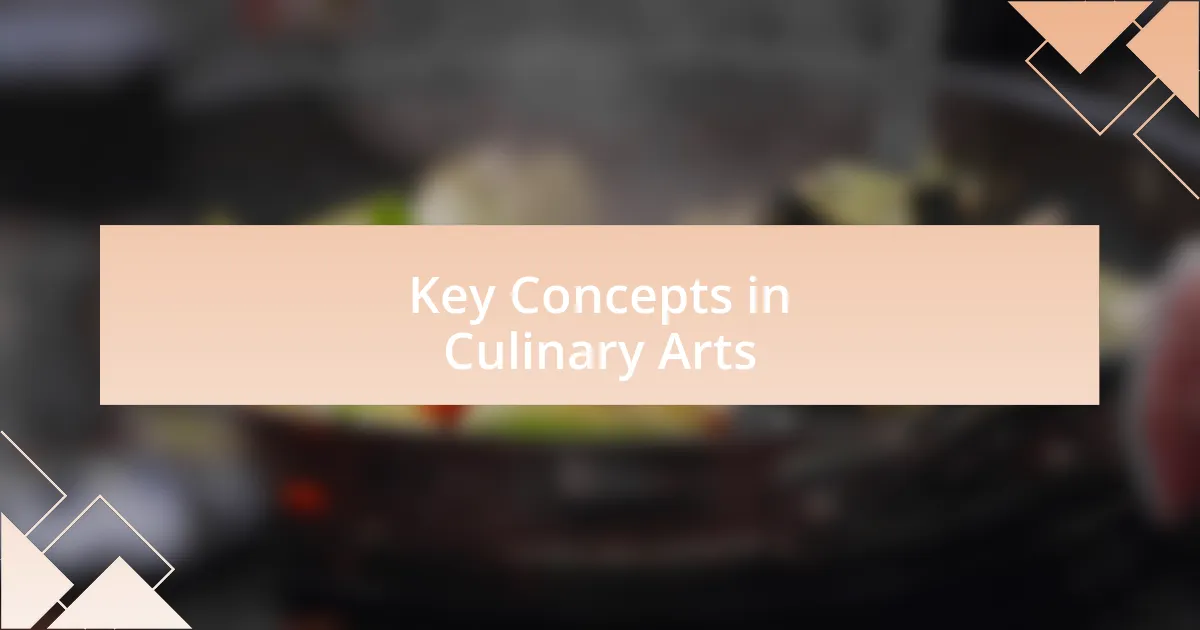
Key Concepts in Culinary Arts
When diving into culinary arts, it’s essential to grasp foundational techniques, such as knife skills and cooking methods. I vividly recall the first time I learned how to properly chop an onion; I felt a rush of empowerment that came with mastering such a basic yet crucial skill. Doesn’t it strike you as amazing how just a few techniques can open the door to endless culinary possibilities?
Another key concept is the importance of flavor balance, which I discovered during a spice pairing workshop. I remember experimenting with sweet, sour, salty, and bitter elements, striving to achieve harmony in my dishes. The profound satisfaction I felt when a seemingly simple combination dazzled my palate made me appreciate the craft even more. How often do you think we overlook the role of balance in our everyday cooking?
Finally, understanding food safety and hygiene is paramount in any culinary journey. I once learned this lesson the hard way when I neglected to properly store ingredients during a busy service. The chaos that ensued led to a deeper respect for safe practices in the kitchen. Isn’t it unsettling to think how such a critical aspect can impact not only our dishes but also the health of those we serve? Embracing these concepts not only enhances our cooking but also elevates our responsibility as chefs.

My Journey into Culinary Exploration
Embarking on my culinary journey was like stepping into a world of vibrant colors and intoxicating aromas. I vividly remember my first experience at a local market, where the clamor of vendors and the rich scents of spices enveloped me. This sensory overload sparked a curiosity that propelled me to explore international cuisines and the stories behind them.
There was a moment during a trip to Italy that left a lasting impression on me. While learning how to make pasta from scratch in a small Tuscan kitchen, I felt a connection to generations of chefs who had shared this craft. The joy of rolling dough and forming tortellini was not just about the food; it was about tradition and the love infused into each bite. Have you ever felt that connection to a dish or cuisine that transcends time and place?
As I dove deeper into global flavors, I encountered challenges that tested my palate and skills. I recall a particularly difficult evening when I attempted to replicate a complex Thai curry. The balance of spices eluded me, causing frustration, but the eventual success was nothing short of euphoric. Each culinary misstep became a lesson, reminding me that exploration is not just about mastery—it’s about embracing the journey and the growth that comes with it. Isn’t that what makes cooking an art form?
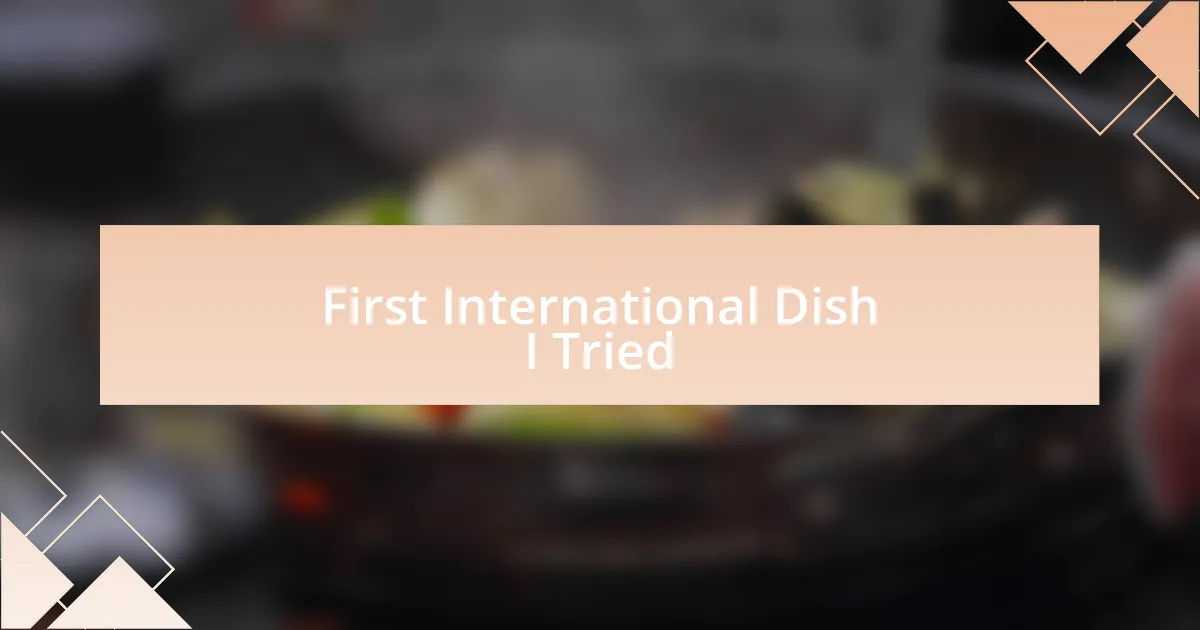
First International Dish I Tried
The first international dish that truly captivated me was sushi. I remember sitting in a quaint little restaurant, excitement buzzing in the air as I watched the chef expertly slice the fish. The delicate combination of rice, seaweed, and fresh fish felt like a revelation on my palate. Have you ever tasted something so surprising that it changed how you viewed food?
What struck me most was the experience of eating sushi—a carefully crafted piece of art. Each bite transported me to Japan, making me realize that food can tell stories and evoke emotions. It’s fascinating how something so simple can hold such complexity and tradition. I still recall the texture of the rice and the subtle taste of wasabi dancing on my tongue.
Trying sushi opened the door to a world of flavors I hadn’t fully understood before. I found myself craving the freshness and artistry involved in creating each roll. It was a lesson in patience as I began to appreciate the preparation behind such an iconic dish. How can a meal made of raw fish and rice bring people together in such a unique way?
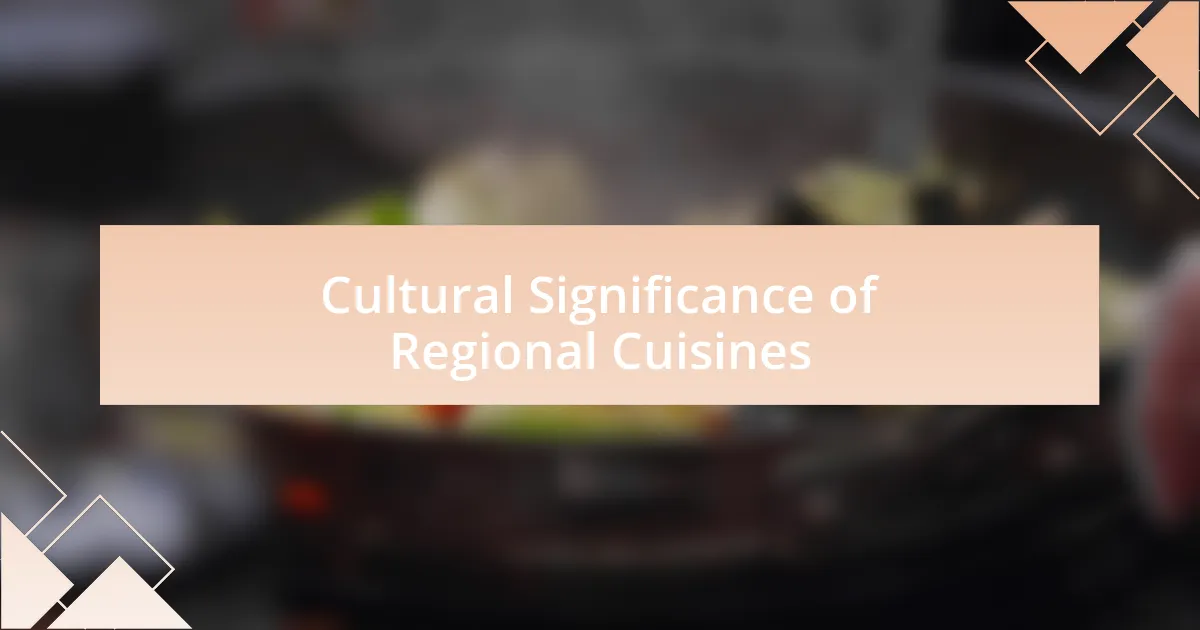
Cultural Significance of Regional Cuisines
Exploring regional cuisines has profoundly shaped my understanding of culture. For instance, during my travels in Mexico, I savored the vibrant flavors of mole, a sauce rich in history and tradition. Each ingredient told a story of indigenous heritage and Spanish influence, revealing how food can serve as a bridge between past and present.
I remember attending a family gathering where dishes from different provinces were served, showcasing the incredible diversity in flavors and cooking methods. This experience opened my eyes to how food isn’t just about nourishment; it’s a powerful reflection of identity, bringing people together and igniting conversations about shared experiences. Have you ever thought about how a single dish can symbolize a whole community’s values and pride?
Living in a multicultural city, I found that trying different regional cuisines allows for a deeper appreciation of varied customs and traditions. One evening, I joined friends for an Ethiopian feast, where communal dining emphasized unity and shared experience. It made me realize that food fosters connections—both within families and across cultures—highlighting the remarkable ways in which culinary traditions enrich our lives.
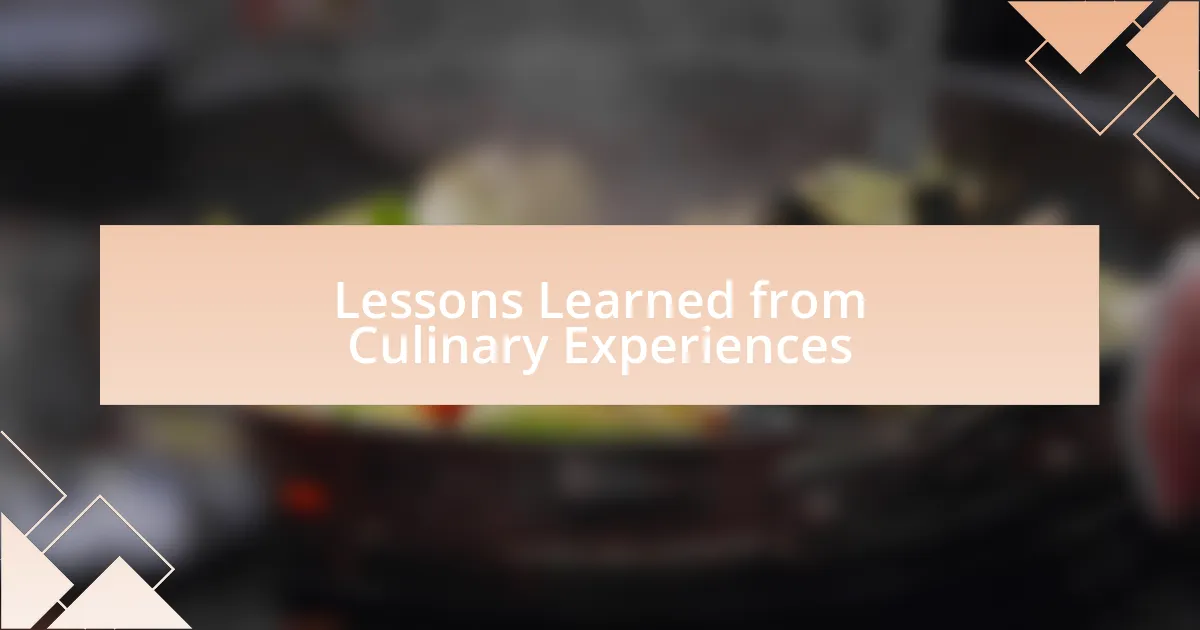
Lessons Learned from Culinary Experiences
Every culinary experience I’ve had has taught me the value of patience. I vividly recall my first attempt at making traditional Japanese ramen. Carefully simmering the broth for hours felt like an eternity, but each moment was necessary for developing that authentic depth of flavor. This taught me that great food often requires time and attention, emphasizing the importance of savoring the process rather than rushing to the end result.
Another lesson that stands out is the power of collaboration in cooking. I once participated in a cooking class focused on Mediterranean cuisine, where we were tasked with creating a feast together. The energy in the kitchen was electric as we shared tasks, laughter, and culinary tips. This experience reinforced my belief that cooking can be a communal endeavor, fostering teamwork and creativity while creating lasting memories.
Have you ever experienced the joy of sharing a dish you’ve created? I will never forget the pride I felt when serving my version of Moroccan tagine to friends. Their delighted reactions highlighted how food can convey love and care, transforming a simple meal into a heartfelt gesture. It’s moments like these that remind me of food’s profound emotional impact and its ability to strengthen bonds.